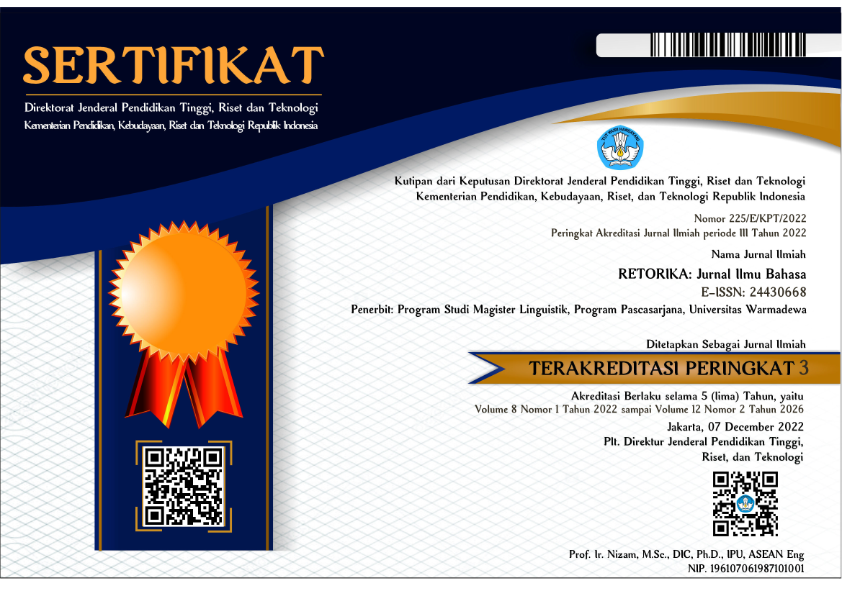Caregivers Experience in Performing Interpersonal Communication and Directive Speech Acts With Elderly in Japan and Bali Nursing Home
Abstract
An increasing number of elderly in Japan and Indonesia, especially Bali, has led to increased health needs to care for them in nursing homes. Health workers, such as caregivers, are the closest people to communicate directly with the elderly. Communication can be called interpersonal communication which is a process of direct information or transfer of understanding of two or more people. Good interpersonal communication will build closeness and intimacy in the process of delivering messages. Therefore this study tried to analyze the experience of caregivers in implementing interpersonal communication and also determine the form of directive speech acts used by caregivers in caring for the elderly in nursing homes. The method used in this research was a qualitative descriptive method by phenomenological approach. The results showed that interpersonal communication applied by caregivers in caring for the elderly provided verbal and non verbal interpersonal communication. In addition, in the communication process of caregive-elderly is also formed directive speech act including prohibitions, requests and questions. In conclusion, caregivers need to have the ability to communicate effectively with elderly.
References
Ariel, M. (2008). Pragmatics and Grammar. Cambridge: Cambridge University Press. Retrieved from https://doi.org/10.1017/CBO9780511791314
Awad, A. G., & Voruganti, L. N. P. (2008). The Burden of Schizophrenia on Caregivers. Journal of Pharmacoeconomics, 26(2), 149–162. Retrieved from https://link.springer.com/article/10.2165/00019053-200826020-00005
DeVito, J. A. (2013). The Interpersonal Communication Book 13th Edition. United States of America: Pearson Education Limited.
Dewi, S. P. A. A. P., Purwaningsih, N. K., & Lindawati, N. P. (2017). Diction Analysis in making Empathetic responses for Diabetic of Nursing Student in STIKES Bina Usada Bali. LITERA : Jurnal Litera Bahasa Dan Sastra, 3(1), 88–97. Retrieved from https://jurnal.undhirabali.ac.id/index.php/litera/article/view/716
Febrianita, R., & Hardjati, S. (2019). The Power of Interpersonal Communication Skill in Enhancing Service Provision. Journal of Social Science Research, 14, 3192–3199. Retrieved from https://doi.org/10.24297/jssr.v14i0.8150
Forsgren, E., Skott, C., Hartelius, L., & Saldert, C. (2016). Communicative barriers and resources in nursing homes from the enrolled nurses’ perspective: A qualitative interview study. International Journal of Nursing Studies, 54, 112–121. Retrieved from https://doi.org/10.1016/j.ijnurstu.2015.05.006
Karumi, A. N. (2016). Peran Perawat dalam Komunikasi Antarpribadi dengan Lansia untuk Membangun Kreativitas (Studi Kasus di Panti Sosial Tresna Werdha Nirwana Puri Samarinda). E-Journal Ilmu Komunikasi, 4(2), 102 – 111. Retrieved from https://ejournal.ilkom.fisip-unmul.ac.id/site/wp-content/uploads/2016/05/Jurnal(05-13-16-07-21-58).pdf
Kung, W. B. (2003). Chinese American Caregiver of Patient with Schizophrenia, Family Challenges. New York: Guildford.
Maskhuri, S. A. (2017). Komunikasi Interpersonal Perawat Dengan Lansia (Studi Deskriptif Kualitatif Komunikasi Perawat Dengan Lansia di Panti Jompo Aisyiyah Kota Surakarta dalam Membangun Kedekatan). Program Studi Ilmu Komunikasi Fakultas Komunikasi Dan Informatika Universitas Muhammadiyah Surakarta. Retrieved from http://eprints.ums.ac.id/57170/1/Skripsi FORMAT PERPUS.pdf
McMullan, A., Parush, A., & Momtahan, K. (2015). Transferring Patient Care: Patterns of Synchronous Bidisciplinary Communication Between Physicians and Nurses During Handoffs in a Critical Care Unit. Journal of Perianesthesia Nursing, 30(2), 92–104. Retrieved from https://doi.org/10.1016/j.jopan.2014.05.009
Pratiwi, D. A. D. P., & Lestari, M. D. (2019). Gambaran dukungan sosial dan penyesuaian diri pada perempuan pegawai negeri sipil prapensiun di Provinsi Bali. Jurnal Psikologi Udayana, 6(2), 328–336. Retrieved from https://doi.org/10.24843/JPU.2019.v06.i02.p12
Purwaningsih, N. K., & Dewi, S. P. A. A. P. (2019). The Analysis of Speech Act in Verbal Communication between Healthcare Professional and Patients in Public Health Centre Branch Kerobokan Kelod. Journal of English Educational Study (JEES), 2(1), 11–20. Retrieved from http://jurnal.stkippersada.ac.id/jurnal/index.php/JEES/article/view/381
Saadati, H., Shoaee, F., Pouryan, A., Alkasir, E., & Lashani, L. (2014). Effectiveness of Gestalt Group Therapy on Loneliness of Women Caregivers of Alzheimer Patients at Home. Iranian Rehabilitation Journal, 12(22), 54–58. Retrieved from https://pdfs.semanticscholar.org/1f39/21921e2a77b8167a2932999b36f3b14d763b.pdf?_ga=2.101350081.1171215894.1587009686-1086103979.1579841271
Searle, J. R. (1985). Expression and Meaning: Studies in the Theory of Speech Acts. Cambridge: Cambridge University Press. Retrieved from https://www.cambridge.org/id/academic/subjects/philosophy/logic/expression-and-meaning-studies-theory-speech-acts?format=PB
Copyright (c) 2020 RETORIKA: Jurnal Ilmu Bahasa

This work is licensed under a Creative Commons Attribution-ShareAlike 4.0 International License.
This journal provides immediate open access to its content on the principle that making research freely available to the public supports a greater global exchange of knowledge.
All articles published Open Access will be immediately and permanently free for everyone to read and download. We are continuously working with our author communities to select the best choice of license options, currently being defined for this journal as follows: Creative Commons-Non Ceomercial-Attribution-ShareAlike (CC BY-NC-SA)
 Abstract viewed = 542 times
Abstract viewed = 542 times
 PDF downloaded = 888 times
PDF downloaded = 888 times

2.png)














